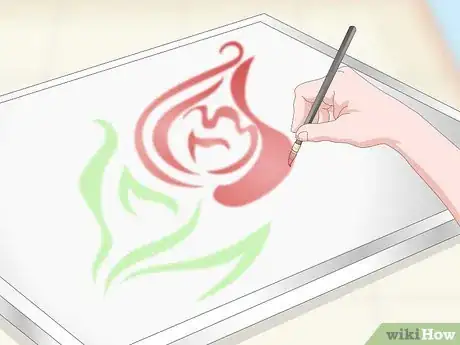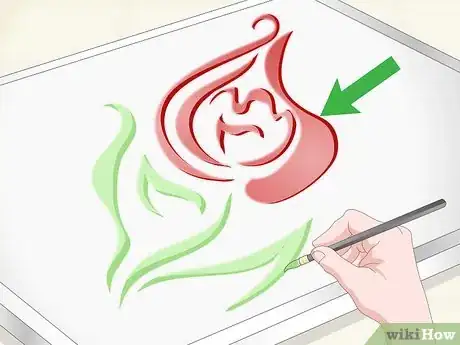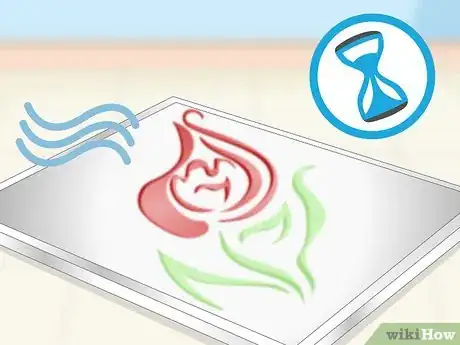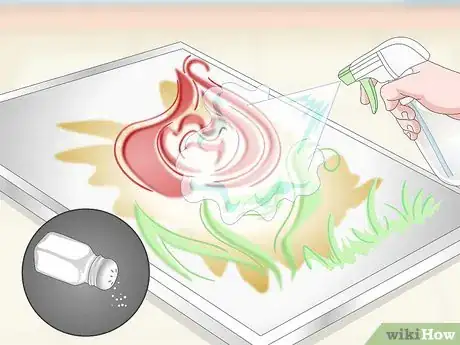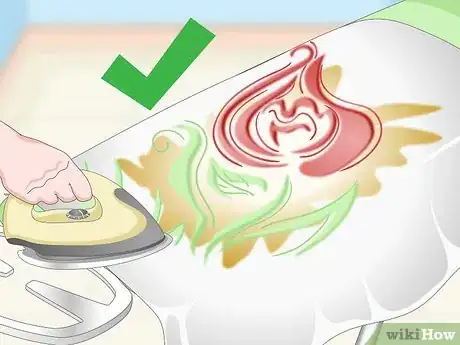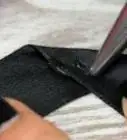This article was co-authored by wikiHow staff writer, Sophia Latorre. Sophia Latorre is a Content Manager on the wikiHow team. Before joining wikiHow, Sophia worked as a technical editor and was published in six International Energy Agency (IEA) Wind Annual Reports. Now, she writes, edits, and reviews articles for the wikiHow Content Team, working to make the content as helpful as possible for readers worldwide. Sophia holds a BA in English from Colorado State University.
wikiHow marks an article as reader-approved once it receives enough positive feedback. In this case, 95% of readers who voted found the article helpful, earning it our reader-approved status.
This article has been viewed 368,972 times.
Learn more...
Painting on silk is a fun and simple project that anyone can undertake. You only need a few materials and a creative mind! There are a few different techniques for painting silk, including the Serti method and the alcohol and salt method. The Serti method creates more distinct lines, while the alcohol and salt method results in softer lines and more textured pieces.
Steps
Setting Up Your Materials
-
1Select paints designed specifically for silk. For best results, you should use silk paints rather than acrylic, oil, watercolor, or any other type of paint. Silk paints are available at craft stores as well as online. You could choose silk dye instead of paint, if desired.[1]
-
2Prewash your silk. It's important to wash your silk to allow for a smoother and more even application of paint. Read the garment tag to see if the item you're painting — say, a scarf — can go in the washing machine, and if not, wash it by hand. Either way, you should use Synthrapol, a silk detergent that can be found at fabric and craft stores.[2]Advertisement
-
3Stretch your silk on a frame. You can purchase or make stretcher bars to hold the silk in place. Make sure the fabric is evenly stretched, and is neither too tight nor too loose. If it's too loose, it will sag and the paint will puddle, but if it's too tight, it may damage the fabric.[3]
Trying the Serti Technique
-
1Draw your design on the silk. Sketch the pattern or design in pencil on a piece of paper first. Trace the design in black marker, allow it to dry, then put the paper underneath the silk. Use a pencil or a vanishing marker to transfer the design onto the silk.[4]
- You can create abstract designs, draw flowers or vines, make a geometric print, or even write letters or words.
-
2Outline the design with resist or gutta. Resist and gutta are used to create clean lines or borders in the paint, and are then removed after painting. Gutta is a chemical solvent that must be removed by a dry cleaner. Resist is a water-based product that can be rinsed out of the fabric with water. Fill a bottle with a small tip applicator with resist or gutta, and hold the bottle vertically, touching the tip to the silk. Carefully trace the outline with a steady hand, applying even pressure. [5]
- Make sure there are no gaps or breaks in the lines, or the paint will spread outside the design.
-
3Allow the resist or gutta to dry fully. Gutta dries quickly, while resist takes longer. To speed up the process, aim a blow dryer, set at medium heat, at the lines. Keep the dryer a few inches from the fabric to avoid scorching it or smearing the resist.[6]
-
4Use a medium-sized paintbrush to apply paint to the item you're painting. Dip a medium-sized paintbrush into the paint color of your choice and lightly brush it on the silk. Take care not to get the paint or paintbrush too close to the resist or gutta, or it may begin to dissolve. Don't worry, though, the paint will naturally spread to the lines. Work quickly on large background areas so that the paint gets absorbed evenly.[7]
- If you notice a gap in your resist/gutta line while painting, either stop the paint from spreading by aiming a blow dryer at it, or fill in the gap with resist/gutta and allow it to dry before continuing.
-
5Set the paint with an iron after 24 hours. Once 24 hours have passed and the paint and resist/gutta are dry, remove the item you're painting from the frame. Plug in your iron and heat it to the silk setting. Lay your item facedown on a covered ironing board. Place an ironing cloth in between it and the iron. Use circular motions to iron small areas for 2-3 minutes each to ensure that the paint, as well as the resist or gutta, is completely set.[8]
-
6Wash the item if you used resist, or dry clean it if you used gutta. In order to remove the resist or gutta, the item must be cleaned. Because resist is water-based, you can rinse the item in warm water to remove it. Then, hang it to dry and iron it on the silk setting while still damp. Gutta requires removal by a dry cleaner.[9]
Creating Effects with Alcohol and Salt
-
1Spray the silk with a diluted mix of water and rubbing alcohol. Use two parts alcohol to one part distilled water. The alcohol provides more time to paint as it slows down the drying time, while also allowing the dye to spread and dry with a soft, fuzzy edge.[10]
-
2Apply the first layer of paint while the silk is still wet. To create designs or patterns on the silk, apply even strokes using a paintbrush dipped in the paint color of your choice. The size of the paintbrush you choose will correspond to how thick or thin the lines or designs are.[11]
-
3Add a darker color next to add dimension. While the silk is still wet, apply your second color. In general, always start with light shades then move on to darker colors (such as a darker shade of your primary color). Since the colors will be transparent, once you go dark, it's hard to go back to light.[12]
-
4Allow the item to dry for a few hours. You may notice some of the colors separating or spreading, which is typical, and can create beautiful blended patterns.[13]
-
5Build your lines or add designs with a dark color. You can choose an even darker shade of your primary color or another color to paint on the dry silk next. These lines will dry with a hard edge and may also have a dark outline around them.[14]
-
6Create effects with alcohol or salt. To soften harsh lines, spray the silk with the diluted alcohol mixture. To add a mottled texture, sprinkle any kind of salt on the silk. Salt is a drying agent which draws the paint toward it, creating a neat effect.[15]
-
7Set the paint with an iron after 24 hours. After the item has dried for 24 hours, brush off any remaining salt and remove it from the frame. Plug in an iron and heat it to the silk setting. Place the item you're painting facedown on a covered ironing board and cover it with an ironing cloth. Iron small sections, using a circular motion, for 2-3 minutes apiece so the paint sets fully.[16]
Community Q&A
-
QuestionHow do I remove wax from a silk scarf after painting it?
 Community AnswerIron it between sheets of newsprint paper without any print on it. Change the paper as needed. If you don't have newsprint available, use normal white paper from your printer.
Community AnswerIron it between sheets of newsprint paper without any print on it. Change the paper as needed. If you don't have newsprint available, use normal white paper from your printer. -
QuestionWhere do I buy the silk and the dyes?
 Community AnswerYou can find the dyes at discount department stores, such as Walmart, and you can find the silk at art supply stores, such as Blick Art Materials.
Community AnswerYou can find the dyes at discount department stores, such as Walmart, and you can find the silk at art supply stores, such as Blick Art Materials. -
QuestionDo I need to "set" the color so it won't run?
 Community AnswerYes, if the paint is specifically for steam fixing then it must be steam fixed, or you can also purchase iron fix paints which can be fixed by pressing them after they are dry.
Community AnswerYes, if the paint is specifically for steam fixing then it must be steam fixed, or you can also purchase iron fix paints which can be fixed by pressing them after they are dry.
Things You'll Need
- Silk scarf or other silk item
- Stretcher bars
- Silk paints
- Paintbrushes
Using the Serti Technique
- Resist or gutta
- Bottle with a small applicator tip
Using Alcohol and Salt
- Rubbing alcohol
- Distilled water
- Spray bottle
- Salt (any kind)
References
- ↑ http://www.silkpainters.org/wiki.php?WID=31
- ↑ http://www.silkpainters.org/wiki.php?WID=31
- ↑ https://www.dharmatrading.com/techniques/silkpaint/silk-painting-techniques.html
- ↑ https://www.dharmatrading.com/techniques/silkpaint/silk-painting-techniques.html
- ↑ https://www.dharmatrading.com/techniques/silkpaint/silk-painting-techniques.html
- ↑ http://fionastolze.com/how-to-dry-gutta-quickly-when-silk-painting
- ↑ http://www.silkpainters.org/wiki.php?WID=33
- ↑ https://www.dharmatrading.com/techniques/silkpaint/silk-painting-techniques.html
- ↑ https://www.dharmatrading.com/techniques/silkpaint/silk-painting-techniques.html
- ↑ https://www.artistsandillustrators.co.uk/how-to/watercolour/238/how-to-begin-silk-painting
- ↑ http://www.silkpainters.org/wiki.php?WID=33
- ↑ https://www.artistsandillustrators.co.uk/how-to/watercolour/238/how-to-begin-silk-painting
- ↑ https://www.dharmatrading.com/techniques/silkpaint/silk-painting-techniques.html
- ↑ https://www.artistsandillustrators.co.uk/how-to/watercolour/238/how-to-begin-silk-painting
- ↑ http://www.silkpainters.org/wiki.php?WID=34
- ↑ https://www.dharmatrading.com/techniques/silkpaint/silk-painting-techniques.html
About This Article
To paint a silk scarf, start by prewashing your silk and allowing it to air dry for a more even application of paint. Next, stretch your silk out in a frame, like an X frame, to keep the fabric even. Then, sketch your design on a piece of paper, and trace over it in black marker. After placing the paper under your scarf, transfer the image onto the silk with a pencil or vanishing marker and outline it with a removable paint, like Resist, to create clean border lines. Once the Resist is dry, use a paintbrush to apply the silk paint to the scarf. Then, wait 24 hours before setting the paint with an iron and rinsing the Resist out of the scarf. To learn how to create softer lines and mottled textures on your silk with alcohol and salt, keep reading!










